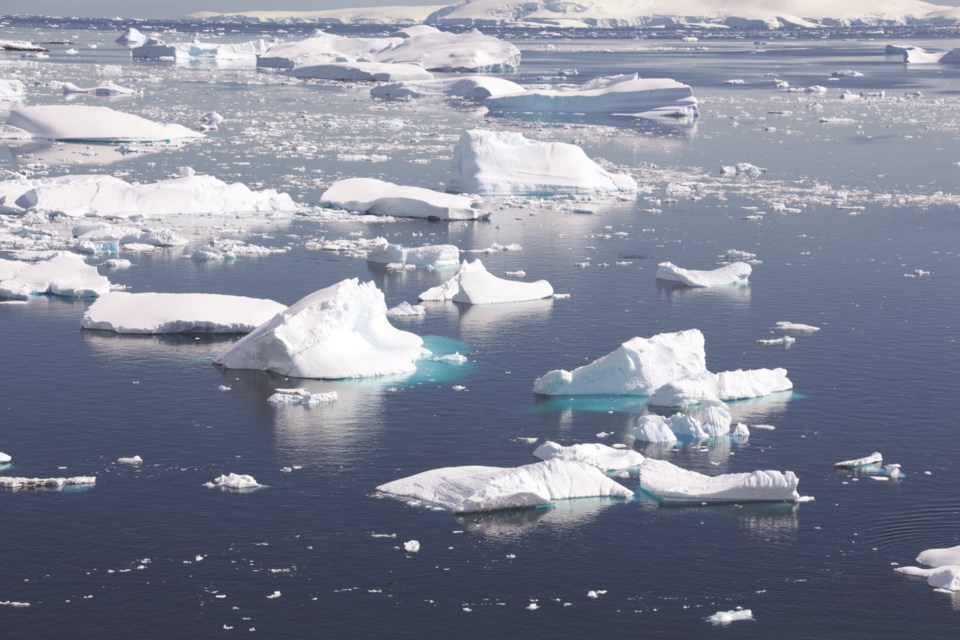It took Meg O’Hara three minutes to reply to an email invitation asking if she’d like to join the SOI Foundation on its trip to Antarctica a mere two-and-a-half weeks later.
“Two people were faster than me,” she says with a laugh.
The Whistlerite was the only artist invited to set sail with the organization—which aims to connect youth and nature to help inspire a more sustainable future—on the expedition for three and a half weeks last December.
“There were a wide variety of people chosen—and from all three coasts,” she says. “They had people coming from all over Canada. I was the only artist, which made it pretty interesting. We would have these conversations around science and the importance of polar regions and the impact of climate change on polar areas. I’m the only one going home and creating paintings about them.”
Part of her immediate desire to join the trip was due to the series she’s currently working on about ancient ice in Canada.
“I couldn’t have asked for a better opportunity,” she adds. “Coming from such a cold place with glaciers everywhere, we’re spoiled [in that] all year round we can see ice. I definitely credit Whistler with making me fall in love with ice. A lot of people don’t get the opportunity to go the places I go—ski tour up the Spearhead Traverse or go on an ice breaker trip or go to Antarctica—but the lessons are valuable for everyone.”
O’Hara—who, in 2021, earned a BCBusiness 30 under 30 award—came away from the trip armed with plenty of interesting scientific facts about the planet’s least-populated and southernmost continent. For one, it houses 90 per cent of the world’s ice.
“It’s the forefront on climate change,” she says. “The polar regions are three or four times more affected by climate change than the rest of the world.”
The continent also adheres to the Antarctic Treaty System, which ensures its environmental protection, use for science, and peace. This year, Canada is hoping to join the 29 other countries with consultative party status to allow for greater influence and scientific contributions to the area.
“We’d have a say in what happens on the continent,” O’Hara says. “We’re in a pretty unique position as a polar nation. We have the longest coastline in the world … and we have a ton of land in the Arctic, scientific research goes on up there and we have Indigenous knowledge of polar regions. So we’re in a unique position to be part of the treaty.”
Aside from her new range of knowledge, O’Hara also had some pretty unique experiences. She saw penguins close up (and learned first-hand about their foul smell), experienced nearly 24-hour daylight (save for a few hours of dusk), and she got to experience the ultimate polar bear dip.
“I’ll ice plunge all year long in Nita Lake,” she says. “But 0 C is so cold. Because of the salt content, it doesn’t freeze, but it’s close to freezing. It’s a bit like swimming in a slushy; the water is viscous. Not to brag, but I lasted the longest. I lasted a minute and the doctor was like, ‘You have to get out.’”
Art-wise, the cold made it hard for O’Hara to make use of the watercolours she brought along too often. (Typically she prefers acrylic on canvas.) But she was sure to take studio sketches and photos to bring home for future paintings.
“The mountains are iconic down there; they shoot straight out of the ocean, but what interested me the most was ice and the icebergs,” she says. “There were two main types of ice—the glaciers on the shoreline and the ice sheets.”
The icebergs, in particular, captured her imagination.
“When an iceberg floats by, you can decipher its life based on how it looks,” she says. “You can see a line of sediment, you can see where it was parallel to the ground or what part has been weathered by the water. Or you can just tell which iceberg is brand new, which just broke off from a glacier. There’s no way of saying this without sounding cheesy, but they look like sculptures that are carved by nature.”
The first part of O’Hara’s ancient ice series will debut at The Artist Project in Toronto in April. To see some of the pieces, keep your eye on her website at megoharacreative.com or Instagram at instagram.com/megoharacreative.
For more on the SOI Foundation—which has expeditions for youth—visit soifoundation.org/en.




